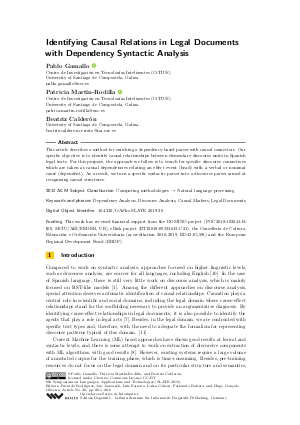Identifying Causal Relations in Legal Documents with Dependency Syntactic Analysis
Authors
Pablo Gamallo  ,
Patricia Martín-Rodilla
,
Patricia Martín-Rodilla  ,
Beatriz Calderón
,
Beatriz Calderón
-
Part of:
Volume:
8th Symposium on Languages, Applications and Technologies (SLATE 2019)
Part of: Series: Open Access Series in Informatics (OASIcs)
Part of: Conference: Symposium on Languages, Applications and Technologies (SLATE) - License:
 Creative Commons Attribution 3.0 Unported license
Creative Commons Attribution 3.0 Unported license
- Publication Date: 2019-07-24
File

PDF
OASIcs.SLATE.2019.20.pdf
- Filesize: 347 kB
- 6 pages
Document Identifiers
Subject Classification
ACM Subject Classification
- Computing methodologies → Natural language processing
Keywords
- Dependency Analysis
- Discourse Analysis
- Causal Markers
- Legal Documents
Metrics
- Access Statistics
-
Total Accesses (updated on a weekly basis)
0PDF Downloads0Metadata Views
Abstract
This article describes a method for enriching a dependency-based parser with causal connectors. Our specific objective is to identify causal relationships between elementary discourse units in Spanish legal texts. For this purpose, the approach we follow is to search for specific discourse connectives which are taken as causal dependencies relating an effect event (head) with a verbal or nominal cause (dependent). As a result, we turn a specific syntactic parser into a discourse parser aimed at recognizing causal structures.
Cite As Get BibTex
Pablo Gamallo, Patricia Martín-Rodilla, and Beatriz Calderón. Identifying Causal Relations in Legal Documents with Dependency Syntactic Analysis. In 8th Symposium on Languages, Applications and Technologies (SLATE 2019). Open Access Series in Informatics (OASIcs), Volume 74, pp. 20:1-20:6, Schloss Dagstuhl – Leibniz-Zentrum für Informatik (2019)
https://doi.org/10.4230/OASIcs.SLATE.2019.20
BibTex
@InProceedings{gamallo_et_al:OASIcs.SLATE.2019.20,
author = {Gamallo, Pablo and Mart{\'\i}n-Rodilla, Patricia and Calder\'{o}n, Beatriz},
title = {{Identifying Causal Relations in Legal Documents with Dependency Syntactic Analysis}},
booktitle = {8th Symposium on Languages, Applications and Technologies (SLATE 2019)},
pages = {20:1--20:6},
series = {Open Access Series in Informatics (OASIcs)},
ISBN = {978-3-95977-114-6},
ISSN = {2190-6807},
year = {2019},
volume = {74},
editor = {Rodrigues, Ricardo and Janou\v{s}ek, Jan and Ferreira, Lu{\'\i}s and Coheur, Lu{\'\i}sa and Batista, Fernando and Gon\c{c}alo Oliveira, Hugo},
publisher = {Schloss Dagstuhl -- Leibniz-Zentrum f{\"u}r Informatik},
address = {Dagstuhl, Germany},
URL = {https://drops.dagstuhl.de/entities/document/10.4230/OASIcs.SLATE.2019.20},
URN = {urn:nbn:de:0030-drops-108870},
doi = {10.4230/OASIcs.SLATE.2019.20},
annote = {Keywords: Dependency Analysis, Discourse Analysis, Causal Markers, Legal Documents}
}
Author Details
- Centro de Investigación en Tecnoloxías Intelixentes (CiTIUS), University of Santiago de Compostela, Galiza
- Centro de Investigación en Tecnoloxías Intelixentes (CiTIUS), University of Santiago de Compostela, Galiza
Funding
This work has received financial support from the DOMINO project (PGC2018-102041-B-I00, MCIU/AEI/FEDER, UE), eRisk project (RTI2018-093336-B-C21), the Consellería de Cultura, Educación e Ordenación Universitaria (accreditation 2016-2019, ED431G/08) and the European Regional Development Fund (ERDF).
References
-
Iria da Cunha. A Symbolic Corpus-based Approach to Detect and Solve the Ambiguity of Discourse Markers. Research in Computing Science, 70:95-106, 2013.

- P. Gamallo, M. Garcia, C. Piñeiro, R. Martinez-Castaño, and J. C. Pichel. LinguaKit: A Big Data-Based Multilingual Tool for Linguistic Analysis and Information Extraction. In 2018 Fifth International Conference on Social Networks Analysis, Management and Security (SNAMS), pages 239-244, 2018. URL: http://dx.doi.org/10.1109/SNAMS.2018.8554689.
-
Pablo Gamallo. Dependency Parsing with Compression Rules. In Proceedings of the 14th International Workshop on Parsing Technology (IWPT 2015), pages 107-117, Bilbao, Spain, 2015. Association for Computational Linguistics.

-
Pablo Gamallo and Marcos Garcia. Dependency parsing with finite state transducers and compression rules. Information Processing &Management, Available online 5 June 2018, 2018.

-
Pablo Gamallo and Isaac González. A Grammatical Formalism Based on Patterns of Part-of-Speech Tags. International Journal of Corpus Linguistics, 16(1):45-71, 2011.

-
Johan Hall and Jens Nilsson. CoNLL-X shared task on multilingual dependency parsing. In The tenth CoNLL, 2006.

- Rinke Hoekstra and Joost Breuker. Commonsense Causal Explanation in a Legal Domain. Artificial Intelligence Law, 15(3):281-299, 2007. URL: http://dx.doi.org/10.1007/s10506-007-9033-5.
- Shafiq Joty, Giuseppe Carenini, and Raymond T. Ng. CODRA: A Novel Discriminative Framework for Rhetorical Analysis. Computational Linguistics, 41(3):385-435, 2015. URL: http://dx.doi.org/10.1162/COLI_a_00226.
- Sujian Li, Liang Wang, Ziqiang Cao, and Wenjie Li. Text-level Discourse Dependency Parsing. In Proceedings of the 52nd Annual Meeting of the Association for Computational Linguistics (Volume 1: Long Papers), pages 25-35, Baltimore, Maryland, June 2014. Association for Computational Linguistics. URL: http://dx.doi.org/10.3115/v1/P14-1003.
-
Amália Mendes and Iria del Río. Using a Discourse Bank and a Lexicon for the Automatic Identification of Discourse Connectives. In Aline Villavicencio, Viviane Moreira, Alberto Abad, Helena Caseli, Pablo Gamallo, Carlos Ramisch, Hugo Gonçalo Oliveira, and Gustavo Henrique Paetzold, editors, Computational Processing of the Portuguese Language, pages 211-221, Cham, 2018. Springer International Publishing.

- Marie-Francine Moens, Caroline Uyttendaele, and Jos Dumortier. Intelligent Information Extraction from Legal Texts. Information &Communications Technology Law, 9(1):17-26, 2000. URL: http://dx.doi.org/10.1080/136008300111583.
- Chaveevan Pechsiri and Asanee Kawtrakul. Mining Causality for Explanation Knowledge from Text. J. Comput. Sci. Technol., 22(6):877-889, 2007. URL: http://dx.doi.org/10.1007/s11390-007-9093-8.
- Kenji Sagae. Analysis of Discourse Structure with Syntactic Dependencies and Data-Driven Shift-Reduce Parsing. In Proceedings of the 11th International Conference on Parsing Technologies (IWPT'09), pages 81-84, Paris, France, October 2009. Association for Computational Linguistics. URL: https://www.aclweb.org/anthology/W09-3813.
-
Maite Taboada and María de los Ángeles Gómez-González. Discourse markers and coherence relations: Comparison across markers, languages and modalities, 2012.

